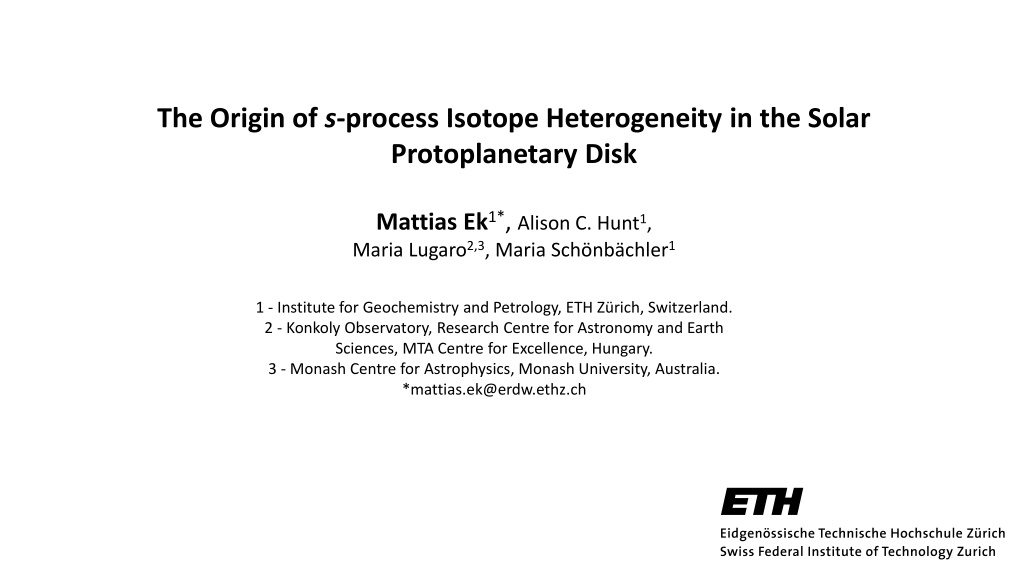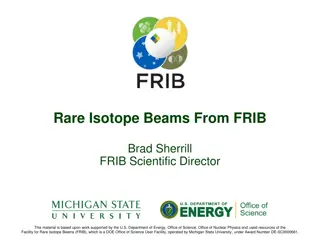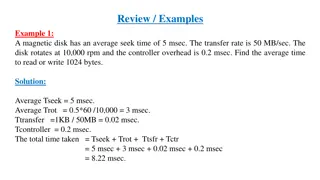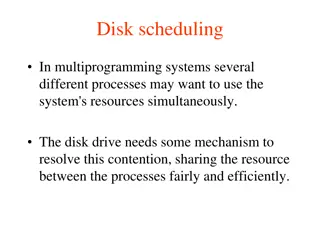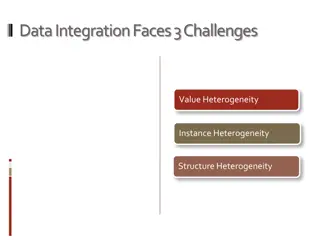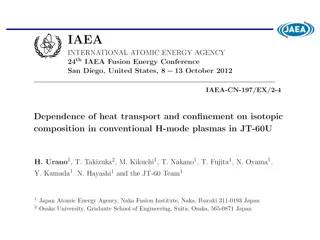Understanding Isotope Heterogeneity in Solar Protoplanetary Disk
Explore the origin of s-process isotope heterogeneity in the solar protoplanetary disk, delving into cosmochemistry, isotopic variations in meteorites, and the significance of internal normalization. Discover the correlation between Pd isotope compositions in iron meteorites and the solar system s-process endmember.
Download Presentation

Please find below an Image/Link to download the presentation.
The content on the website is provided AS IS for your information and personal use only. It may not be sold, licensed, or shared on other websites without obtaining consent from the author. Download presentation by click this link. If you encounter any issues during the download, it is possible that the publisher has removed the file from their server.
E N D
Presentation Transcript
The Origin of s-process Isotope Heterogeneity in the Solar Protoplanetary Disk Mattias Ek1*, Alison C. Hunt1, Maria Lugaro2,3, Maria Sch nb chler1 1 - Institute for Geochemistry and Petrology, ETH Z rich, Switzerland. 2 - Konkoly Observatory, Research Centre for Astronomy and Earth Sciences, MTA Centre for Excellence, Hungary. 3 - Monash Centre for Astrophysics, Monash University, Australia. *mattias.ek@erdw.ethz.ch
Cosmochemistry is the study of physical samples most often meteorites or meteorite components. Iron Meteorite (IIAB) Chondrite (Carbonaceous)
Isotopic varations in meteorites Mass independent isotope variations can be generated by Heterogenous distribution of nucleosynthetic material Radioactive decay Exposure to galactic cosmic rays Mass dependent isotope variations can arise from Geological/biological processes Chemical seperation of elements Isotopic analysis ? ??/?= ??/? ??/? To remove the effects of mass dependent fractionation from an analysis we can internally normalise the sample. Photo: L. Iseli
Internal normalisation ???????????/105?? ???????????/105?? 1 104 ???? = By normalising the value of a certain ratio to a fixed value we can remove any mass dependent fractionation from the data. ? ??/?= ??/? ??/? Palladium is internally normalised to 108Pd/105Pd = 1.18899 s-process defecit
Internal normalisation ???????????/105?? ???????????/105?? ???? = 1 104 By normalising the value of a certain ratio to a fixed value we can remove any mass dependent fractionation from the data. ? ??/?= ??/? ??/? Palladium is internally normalised to 108Pd/105Pd = 1.18899 However, this can also skew the pattern of any mass independent anomaly present in the sample. s-process defecit
We measured the Pd isotope composition of iron meteorites from several different groups. The variation is in good agreement with that predicted by mixing line with the Solar System s-process endmember from Bisterzo et al. (2011). This linear correlation between different meteorite groups has been reported for many refractory s-process elements, e.g. Zr, Mo, Ru, Ba, Nd, W. ???????????/105?? ???????????/105?? ???? = 1 104
The slope of the Ru-Mo correlation is in good agreement with a mixing line with the bulk Solar System s-process composition. Dataset from Hopp et al., Earth Planet. Sci. Lett. 312,2020
The slope of the Ru-Mo correlation is in good agreement with a mixing line with the bulk Solar System s-process composition. We find a linear correlation between Mo-Ru and Pd that suggest a common origin of the s-process nucleosynthetic variation in the Solar System. However, the offsets in Pd are only a third of that predicted by variable mixing of the bulk Solar System s-process endmember based on the Mo-Ru offsets. Therefore, the composition of stardust was not the same as the bulk solar system s-process component.
We attribute the smaller Pd offsets to incomplete condensation of elements into stardust as a function of the elemental condensation temperature. It has been shown that stardust is depleted in elements with lower condensation temperatures. Palladium is less refractory than Mo and Ru and therefore did not as readily condense into stardust. This can also explain the lack on nucleosynthetic offsets in elements even more volatile than Pd such as Te[1] and Cd[2]. [1] Fehr et al., Geochim. Cosmochim. Acta 69, 2005 [2] Toth et al., Geochim. Cosmochim. Acta 274, 2020 Figure from Ireland et al., Geochim. Cosmochim. Acta 221, 2018
Heavy refractory elements (Z 56) also show smaller than expected nucleosynthetic offsets[1]. The production of heavy elements (Z 56) in AGB stars decreases as the metallicity increases. It has been suggested that a large fraction of SiC grain originated from high metallicity AGB stars[2]. Therefore, if a large fraction of stardust originated from high metallicity AGB stars this could explain the smaller than expected nucleosynthetic offsets reported for heavy (Z 56) refractory elements. [1] Qin & Carlson, Geochem. J. 50, 2016 [2] Lugaro et al., Geochim. Cosmochim. Acta 221, 2018 [3] Cristallo et al., J. Phys. Conf. Ser. 665, 2016 Data for a 3 M AGB star from the FRUITY database[2]
Incomplete condensation of elements around high metallicity AGB stars results in dust grains depleted in more volatile elements and the heavy refractory elements.
Incomplete condensation of elements around high metallicity AGB stars results in dust grains depleted in more volatile elements and the heavy refractory elements. Dust mantles grow around stardust in the interstellar medium from a isotopically homogenised gas phase. Stardust (presolar gains) accounts for a few percent of the total dust fraction[1] and was predominately made up of s- process material[2]. [1] Hoppe et al., Nat. Astron. 1, 2017 [2] Zhukovska et al., Astron. Astrophys. 479, 2008
Incomplete condensation of elements around high metallicity AGB stars results in dust grains depleted in more volatile elements and the heavy refractory elements. Dust mantles grow around stardust in the interstellar medium from a isotopically homogenised gas phase. Stardust (presolar gains) accounts for a few percent of the total dust fraction[1] and was predominately made up of s- process material[2]. Thermal processing and/or spatial variations in the protosolar cloud[3] resulted in an progressive enrichment of stardust towards the Sun. [1] Hoppe et al., Nat. Astron. 1, 2017 [2] Zhukovska et al., Astron. Astrophys. 479, 2008 [3] Jacquard et al., Astrophys. J. 884, 2019
Incomplete condensation of elements around high metallicity AGB stars results in dust grains depleted in more volatile elements and the heavy refractory elements. Dust mantles grow around stardust in the interstellar medium from a isotopically homogenised gas phase. Stardust (presolar gains) accounts for a few percent of the total dust fraction[1] and was predominately made up of s- process material[2]. Thermal processing and/or spatial variations in the protosolar cloud[3] resulted in an progressive enrichment of stardust towards the Sun. The formation of Jupiter core [4]/migration of the snow line[5] prohibits homogenisation between the inner and outer disk. [1] Hoppe et al., Nat. Astron. 1, 2017 [2] Zhukovska et al., Astron. Astrophys. 479, 2008 [3] Jacquard et al., Astrophys. J. 884, 2019 [4] Kruijer et al., Proc. Natl Acad. Sci. USA 114, 2017 [5] Lichtenberg et al., Science 371, 2021
Incomplete condensation of elements around high metallicity AGB stars results in dust grains depleted in more volatile elements and the heavy refractory elements. Dust mantles grow around stardust in the interstellar medium from a isotopically homogenised gas phase. Stardust (presolar gains) accounts for a few percent of the total dust fraction[1] and was predominately made up of s- process material[2]. Thermal processing and/or spatial variations in the protosolar cloud[3] resulted in an progressive enrichment of stardust towards the Sun. The formation of Jupiter core [4]/migration of the snow line[5] prohibits homogenisation between the inner and outer disk. Thank you for listening!
